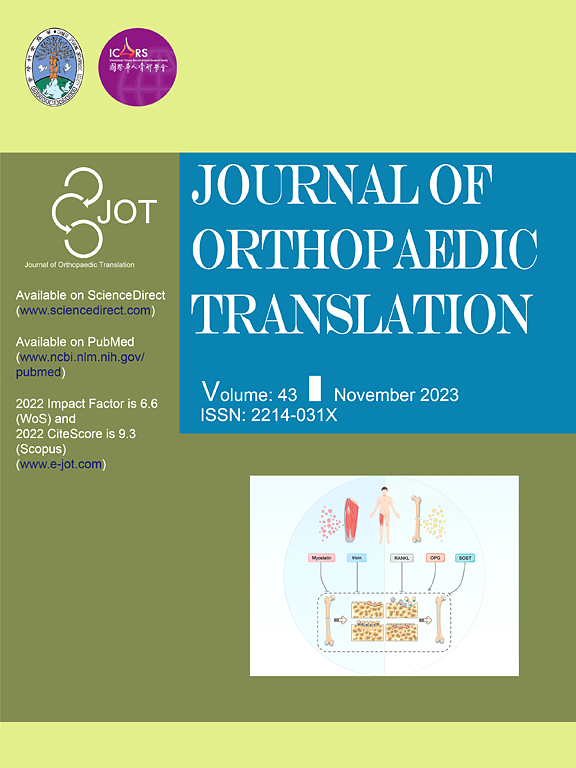通过呈现三功能肽,使种植体表面血管化和骨整合增强
IF 5.9
1区 医学
Q1 ORTHOPEDICS
引用次数: 0
摘要
背景钛基植入物在临床应用中表现出良好的机械性能和生物相容性,但其固有的低生物活性和骨结合过程中复杂的生物行为导致植入物长期失效率居高不下。虽然在种植体表面固定高生物活性肽是改善骨结合的有效策略,但现有的单功能和双功能肽改性种植体表面难以满足骨结合过程中细胞行为调控和组织再生的需要,迫切需要开发更高效的表面改性技术。方法在本研究中,通过将具有特定生物学功能的三肽系统(细胞粘附肽 RGD、成骨生长肽 OGP 和促血管生成肽 ang)的一端与六聚赖氨酸连接,成功制备了多功能肽改性种植体材料 MPN@K6、通过赖氨酸和多酚之间的非共价作用,在金属-多酚涂层(MPN)表面构建三肽系统,然后使用 MPN@K6 - RGD/OGP/ang 作为多肽修饰。结果MPN@K6-RGD/OGP/Ang涂层不仅支持BMSCs的早期粘附和迁移、晚期成骨和矿化,还促进了HUVECs的粘附、迁移和血管化。RT-qPCR 结果显示,混合肽能上调血管生成和成骨过程中关键因子的表达。体内测试进一步证实了这些发现,功能肽涂层在早期诱导新骨形成方面的效果是其他双肽组合的 1.5 到 2 倍,证实了三肽协同修饰策略的有效性和优越性。它能更有效地促进早期细胞迁移和粘附,显著诱导成骨细胞分化和矿化,并提高局部血管化水平。本文构建的三功能肽涂层(MPN@K6 - RGD/OGP/Ang)制备工艺温和,生物安全性高,便于规模化生产,对骨组织修复有积极作用,在骨科和牙科植入物中的临床应用潜力巨大。本文章由计算机程序翻译,如有差异,请以英文原文为准。

Endowing implants surface with enhanced vascularization and osseointegration via presenting triple-functional peptides
Background
Titanium-based implants have demonstrated good mechanical properties and biocompatibility in clinical applications, however, their inherent low bioactivity and complex biological behaviors during the process of osseointegration have resulted in a high rate of long-term implant failure. Although the immobilization of highly bioactive peptides on the implant surface is an effective strategy to improve osseointegration, the existing mono- and bifunctional peptide-modified implant surfaces can hardly meet the needs of cell behavior regulation and tissue regeneration during the process of osseointegration, and there is an urgent need for the development of more efficient surface modification technologies.
Methods
In the present study, a multifunctional peptide-modified implant material, MPN@K6, was successfully prepared by linking one end of a tripeptide system (cell adhesion peptide RGD, osteogenic growth peptide OGP, and pro-angiogenic peptide ang), which possesses a specific biological function, to hexameric lysine, and constructing the tripeptide system on the surface of metal-polyphenol coatings (MPNs) by means of non-covalent interactions between the lysine and the polyphenol, and then the MPN@K6 - RGD/OGP/ang was used as a peptide modification. RGD/OGP/ang.
Results
The MPN@K6-RGD/OGP/Ang coating not only supported the early adhesion and migration, late osteogenesis and mineralization of BMSCs, but also promoted the adhesion, migration and vascularization of HUVECs. RT-qPCR results showed that the hybrid peptide up-regulated the expression of key factors in angiogenesis and osteogenesis. In vivo testing further confirmed these findings, with the functional peptide coating being 1.5 to 2 times more effective at inducing new bone formation at an early stage than the other two-peptide combinations, confirming the effectiveness and superiority of the tripeptide synergistic modification strategy.
Conclusions
The results showed that the MPN@K6 - RGD/OGP/ang-modified implant exhibited significant advantages at the cellular level compared to different combinations of bifunctional peptide-coated forms. It was able to promote early cell migration and adhesion more efficiently, significantly induced osteoblast differentiation and mineralization, and enhanced the level of local vascularization. In a rat bone defect animal model, the material demonstrated more excellent bone repair effects and achieved better bone healing results, confirming the effectiveness and superiority of the tripeptide synergistic modification strategy.
The translational potential of this article
The trifunctional peptide coating (MPN@K6 - RGD/OGP/Ang) constructed in this paper has a mild preparation process, is biologically safe, facilitates large-scale production, has a positive effect on bone tissue repair, and has a great potential for clinical application in orthopedic and dental implants.
求助全文
通过发布文献求助,成功后即可免费获取论文全文。
去求助
来源期刊

Journal of Orthopaedic Translation
Medicine-Orthopedics and Sports Medicine
CiteScore
11.80
自引率
13.60%
发文量
91
审稿时长
29 days
期刊介绍:
The Journal of Orthopaedic Translation (JOT) is the official peer-reviewed, open access journal of the Chinese Speaking Orthopaedic Society (CSOS) and the International Chinese Musculoskeletal Research Society (ICMRS). It is published quarterly, in January, April, July and October, by Elsevier.
 求助内容:
求助内容: 应助结果提醒方式:
应助结果提醒方式:


